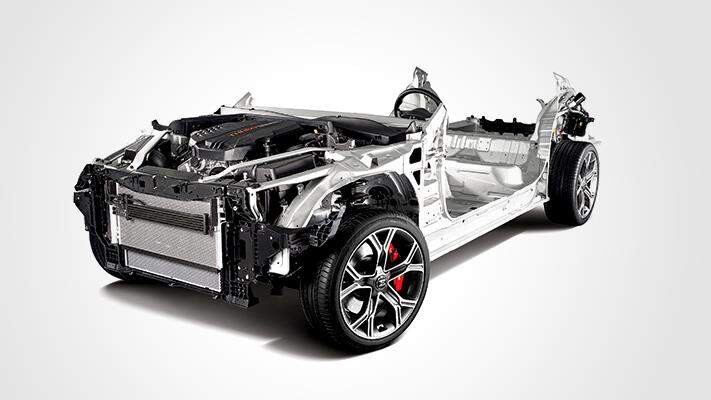In the automotive world, you’ll often hear terms like AWD and 4WD, sometimes used as if they mean the same thing. However, when you ask “What Does Awd Mean On A Car?”, you’re diving into a system that’s distinct from 4WD, especially in how it enhances your driving experience in various conditions. While both systems send power to all four wheels, their applications and mechanics differ significantly. AWD, or All-Wheel Drive, is designed to provide optimal traction and control across diverse on-road situations, whereas 4WD is typically geared towards more demanding off-road adventures. Let’s break down what AWD means for your car and how it stands apart.
Defining AWD: All-Wheel Drive Explained
So, what does AWD mean on a car, exactly? AWD stands for All-Wheel Drive, a drivetrain system that, as the name suggests, powers all of a vehicle’s wheels – front and rear – all the time. Unlike some systems that engage only when needed, AWD is typically always active, or engages automatically without driver intervention. This continuous power distribution is key to understanding the benefits of AWD.
 AWD vs 4WD system differences
AWD vs 4WD system differences
The primary advantage of AWD is enhanced traction and stability. By sending power to all wheels, AWD systems minimize wheel slip, providing better grip on slippery surfaces like wet, icy, or snowy roads. This makes AWD particularly beneficial in regions with inclement weather. Modern AWD systems are sophisticated, often using sensors to detect wheel slippage and adjust power distribution accordingly, optimizing traction in real-time. This automatic and proactive nature is a core aspect of what AWD means for car performance and safety.
AWD vs. 4WD: Key Differences
While both AWD and 4WD deliver power to all four wheels, their design and purpose differ. 4WD, or Four-Wheel Drive, is traditionally found in trucks and SUVs designed for rugged off-road use. 4WD systems often include a low-range gear setting, providing increased torque at lower speeds for challenging terrains like rocks, deep mud, or steep inclines. These systems are built for durability and extreme conditions.
In contrast, AWD is more commonly found in cars, crossovers, and SUVs intended for everyday driving and varied weather conditions. AWD systems prioritize on-road stability and traction in diverse conditions, but typically aren’t designed for the extreme demands of off-roading that 4WD handles. While some modern 4WD systems offer automatic modes that behave similarly to AWD in certain situations, the core engineering and purpose behind each system remain distinct. Understanding this difference is crucial when considering “what does AWD mean on a car” versus 4WD.
AWD in Various Driving Conditions
When considering “what does AWD mean on a car” in practical terms, it’s essential to look at various driving conditions. AWD truly shines in situations where traction is compromised.
- Snow and Rain: AWD systems excel in snowy or rainy conditions. By distributing power to all four wheels, they significantly reduce the chances of wheel spin and loss of control on slippery surfaces. Many modern AWD vehicles even offer “snow” or “low traction” modes to further optimize performance in these conditions.
- Dry Roads: While primarily beneficial in adverse conditions, AWD also offers advantages on dry pavement. The enhanced traction can aid in quicker acceleration and improved handling, particularly in performance-oriented vehicles.
- Off-Road: While 4WD is superior for serious off-roading, AWD can handle light off-road situations like gravel roads or uneven terrain. However, it’s generally not designed for rock crawling, deep water fording, or steep hill climbs like a dedicated 4WD system.
Pros and Cons of AWD
Understanding “what does AWD mean on a car” also involves weighing its advantages and disadvantages.
Pros of AWD:
- Automatic Operation: A major advantage of AWD is its seamless and automatic operation. Drivers don’t need to manually engage or disengage the system, as it works continuously in the background, reacting to changing conditions.
- Wide Vehicle Availability: AWD is available across a broad spectrum of vehicle types, from sedans and wagons to SUVs and crossovers, offering versatility for different needs and preferences.
- Enhanced Traction in Varied Conditions: AWD provides a significant boost in traction and stability across a wide range of on-road conditions, including dry, wet, and snowy surfaces.
Cons of AWD:
- Fuel Efficiency: Vehicles with AWD generally experience slightly lower fuel economy compared to their 2WD counterparts. The added weight and complexity of the AWD system contribute to this decrease.
- Off-Road Limitations: While capable in light off-road situations, AWD is not as robust or capable as 4WD for serious off-road driving.
Lesser-Known Facts About AWD
Beyond the basics of “what does AWD mean on a car”, there are some less commonly known aspects. For instance, AWD isn’t just for bad weather. The enhanced traction it provides can be beneficial in dry conditions as well, aiding in quicker acceleration and more confident handling. This is why some sports cars and performance vehicles are adopting AWD systems to maximize power delivery to the road.
Furthermore, electronic AWD systems are becoming increasingly prevalent, especially in luxury vehicles. These advanced systems can dynamically adjust power distribution between the front and rear wheels, often favoring the rear wheels in normal driving for a sportier feel and improved efficiency, and then seamlessly shifting power to the front when needed for traction. This blend of efficiency and performance highlights the evolving nature of “what does AWD mean on a car” in modern automotive technology.
Conclusion
In summary, “what does AWD mean on a car?” It refers to All-Wheel Drive, a system designed to continuously power all four wheels, enhancing traction and stability in a variety of driving conditions, particularly on paved roads and in inclement weather. While it shares the goal of four-wheel power with 4WD, AWD is distinct in its automatic operation and focus on on-road performance, making it a valuable feature for drivers seeking enhanced control and confidence in their daily driving experience.
